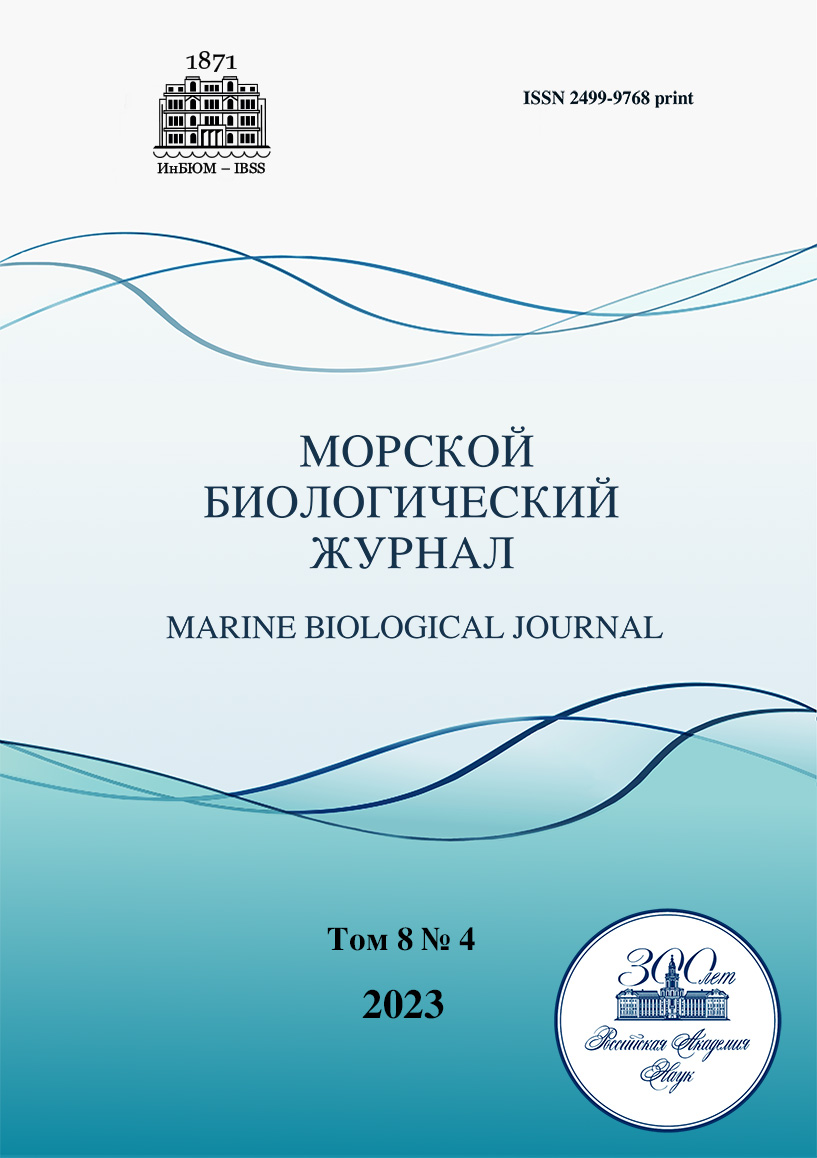Functional morphology and morphological variability of the operculum of Rapana venosa (Gastropoda, Muricidae)
##plugins.themes.ibsscustom.article.main##
##plugins.themes.ibsscustom.article.details##
Abstract
The gastropod Rapana venosa has spread from the Western Pacific to the Black Sea, Mediterranean Sea, and coastal areas on both sides of the Atlantic Ocean largely due to its ecological and morphological plasticity. Numerous works have been devoted to the study of the variability of the rapa whelk shell. The functional morphology and morphological variability of the R. venosa operculum have been insufficiently studied, and the description of this exosomatic organ is given only schematically. Based on the analysis of 190 R. venosa specimens sampled in two areas of the Black Sea, detailed description is given, and trends in the morphological variability of the operculum are shown depending on the specimen age and size. The characteristics determining the normal and aberrant development of the operculum are evaluated. It is shown for the first time that R. venosa has regenerative capabilities, up to the restoration of the lost operculum, and morphogenetic adaptive potential. A manifestation of this potential is the formation of a hypertrophied large operculum, with the shape that is not characteristic of any other Muricidae species and gastropods in general. Apparently, the abnormal size and shape of the operculum are a defensive response to pressure from predators, especially crabs. The previously unknown ability to regenerate the operculum broadens the understanding of the physiological capabilities of the rapa whelk. The phenomenon of operculum formation with a unique shape for gastropods is another manifestation of morphological plasticity, which made R. venosa one of the most successful invasive species in the modern marine environment.
Authors
References
Бондарев И. П. Морфогенез раковины и внутривидовая дифференциация рапаны Rapana venosa (Valenciennes, 1846) // Ruthenica. 2010. Т. 20, № 2. С. 69–90. [Bondarev I. P. The shell morphogenesis and intraspecific differentiation of Rapana venosa (Valenciennes, 1846). Ruthenica, 2010, vol. 20, no. 2, pp. 69–90. (in Russ.)]
Бондарев И. П. Структура популяций Rapana venosa (Gastropoda, Muricidae) севастопольских бухт (Чёрное море) // Морской биологический журнал. 2016. Т. 1, № 3. С. 14–21. [Bondarev I. P. Structure of Rapana venosa (Gastropoda, Muricidae) population of Sevastopol bays (the Black Sea). Morskoj biologicheskij zhurnal, 2016, vol. 1, no. 3, pp. 14–21. (in Russ.)]. https://doi.org/10.21072/mbj.2016.01.3.02
Голиков А. Н., Старобогатов Я. И., Скарлато О. А. Тип моллюски – Mollusca // Определитель фауны Чёрного и Азовского морей. Т. 3 : Членистоногие (кроме ракообразных), моллюски, иглокожие, щетинкочелюстные, хордовые. Киев : Наукова думка, 1972. С. 60–249. [Golikov A. N., Starobogatov Ya. I., Skarlato O. A. Tip mollyuski – Mollusca. In: Opredelitel’ fauny Chernogo i Azovskogo morei. Vol. 3 : Chlenistonogie (krome rakoobraznykh), mollyuski, iglokozhie, shchetinkochelyustnye, khordovye. Kyiv : Naukova dumka, 1972, pp. 60–249. (in Russ.)]
Драпкин Е. И. Новый моллюск в Чёрном море // Природа. 1953. № 9. С. 92–95. [Drapkin E. I. Novyi mollyusk v Chernom more. Priroda, 1953, no. 9, pp. 92–95. (in Russ.)]
Чухчин В. Д. Рост рапаны (Rapana bezoar L.) в Севастопольской бухте // Труды Севастопольской биологической станции. 1961. Т. 14. С. 169–177. [Chukhchin V. D. Rost rapany (Rapana bezoar L.) v Sevastopol’skoi bukhte. Trudy Sevastopol’skoi biologicheskoi stantsii, 1961, vol. 14, pp. 169–177. (in Russ.)]. https://repository.marine-research.ru/handle/299011/5503
Чухчин В. Д. Функциональная морфология рапаны. Киев : Наукова думка, 1970. 139 с. [Chukhchin V. D. Funktsional’naya morfologiya rapany. Kyiv : Naukova dumka, 1970, 139 p. (in Russ.)]. https://repository.marine-research.ru/handle/299011/1125
Чухчин В. Д. Экология брюхоногих моллюсков Чёрного моря. Киев : Наукова думка, 1984. 176 с. [Chukhchin V. D. Ekologiya bryukhonogikh mollyuskov Chernogo morya. Kyiv : Naukova dumka, 1984, 176 p. (in Russ.)]. https://repository.marine-research.ru/handle/299011/5646
Alien Species Alert: Rapana venosa (Veined Whelk) / R. Mann, A. Occhipinti, J. M. Harding (Eds). Copenhagen, Denmark : ICES, 2004, 14 p. (ICES Cooperative Research Report ; no. 264). https://doi.org/10.17895/ices.pub.5471
Bondarev I. P. Dynamics of Rapana venosa (Valenciennes, 1846) (Gastropoda: Muricidae) population in the Black Sea. International Journal of Marine Science, 2014, vol. 4, no. 3, pp. 42–56.
Bondarev I. P. Ecomorphological analyses of marine mollusks’ shell thickness of Rapana venosa (Valenciennes, 1846) (Gastropoda: Muricidae). International Journal of Marine Science, 2013, vol. 3, no. 45, pp. 368–388.
Bondarev I. P. Sexual differentiation and variations sexual characteristics Rapana venosa (Valenciennes, 1846). International Journal of Marine Science, 2015, vol. 5, no. 19, pp. 1–10.
Choi J.-D., Ryu D.-K. Age and growth of purple whelk, Rapana venosa (Gastropoda: Muricidae) in the West Sea of Korea. Korean Journal of Malacology, 2009, vol. 25, no. 3, pp. 189–196.
Keppens M., Dhondt K., Mienis H. K. The variability of the operculum in Nucella lapillus (Gastropoda, Muricidae) from a colony in Audresselles, France. Vita Malacologica, 2008, vol. 7, pp. 15–20.
Kosyan A. R., Antipushkina Zh. A. Determination of Rapana venosa individuals’ ages based on the δ18O dynamics of the shell carbonates. Oceanology, 2011, vol. 51, no. 6, pp. 1021–1028. http://dx.doi.org/10.1134/S0001437011060075
Kosyan A. R. Comparative analysis of Rapana venosa (Valenciennes, 1846) from different biotopes of the Black Sea based on its morphological characteristics. Oceanology, 2013, vol. 53, no. 1, pp. 47–53. https://doi.org/10.1134/S0001437013010074
SigmaPlot 15.0 : [site]. 2023. URL: https://sigmaplot.software.informer.com/15.0 [accessed: 07.04.2023].
Slynko E. E., Slynko Y. V., Rabushko V. I. Adaptive strategy of Rapana venosa (Gastropoda, Muricidae) in the invasive population of the Black Sea. Biosystems Diversity, 2020, vol. 28, no. 1, pp. 48–52. https://doi.org/10.15421/012008
Vasconcelos P., Gharsallah I. H., Moura P., Zamouri-Langar N., Gaamour A., Missaoui H., Jarboui O., Gaspar M. B. Appraisal of the usefulness of operculum growth marks for ageing Hexaplex trunculus (Gastropoda: Muricidae): Comparison between surface striae and adventitious layers. Marine Biology Research, 2012, vol. 8, iss. 2, pp. 141–153. https://doi.org/10.1080/17451000.2011.616896
Xue D. X., Graves J., Carranza A., Sylantyev S., Snigirov S., Zhang T., Liu J.-X. Successful worldwide invasion of the veined rapa whelk, Rapana venosa, despite a dramatic genetic bottleneck. Biological Invasions, 2018, vol. 20, pp. 3297–3314. https://doi.org/10.1007/s10530-018-1774-4


 Google Scholar
Google Scholar



